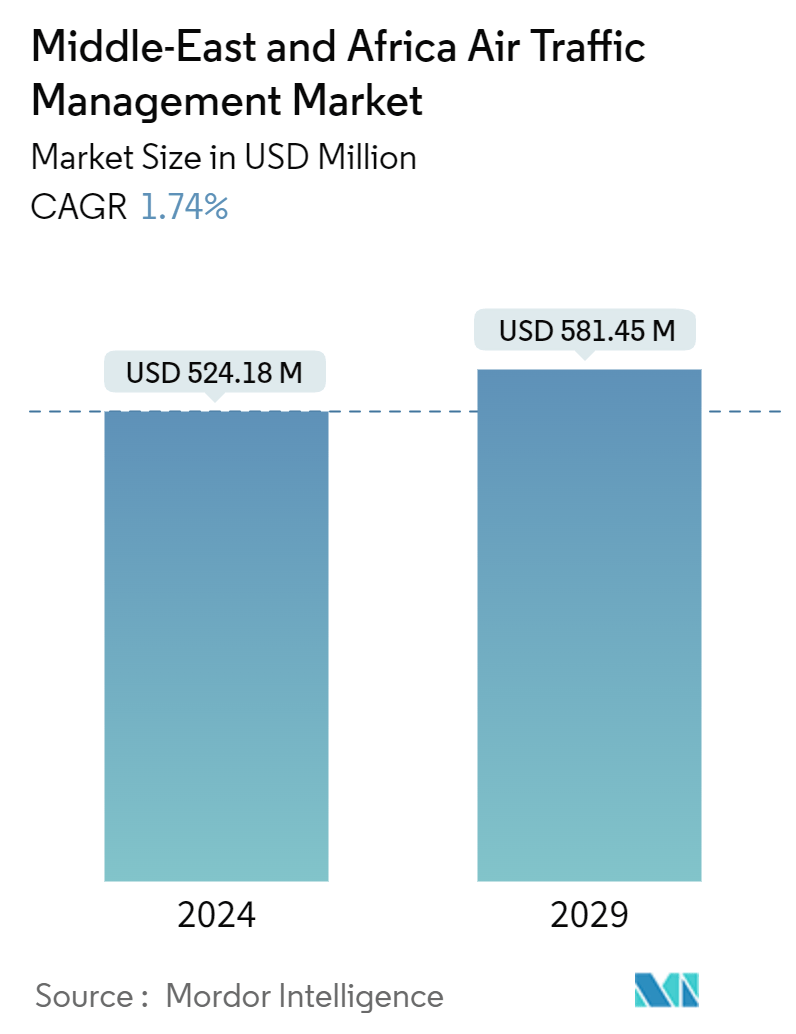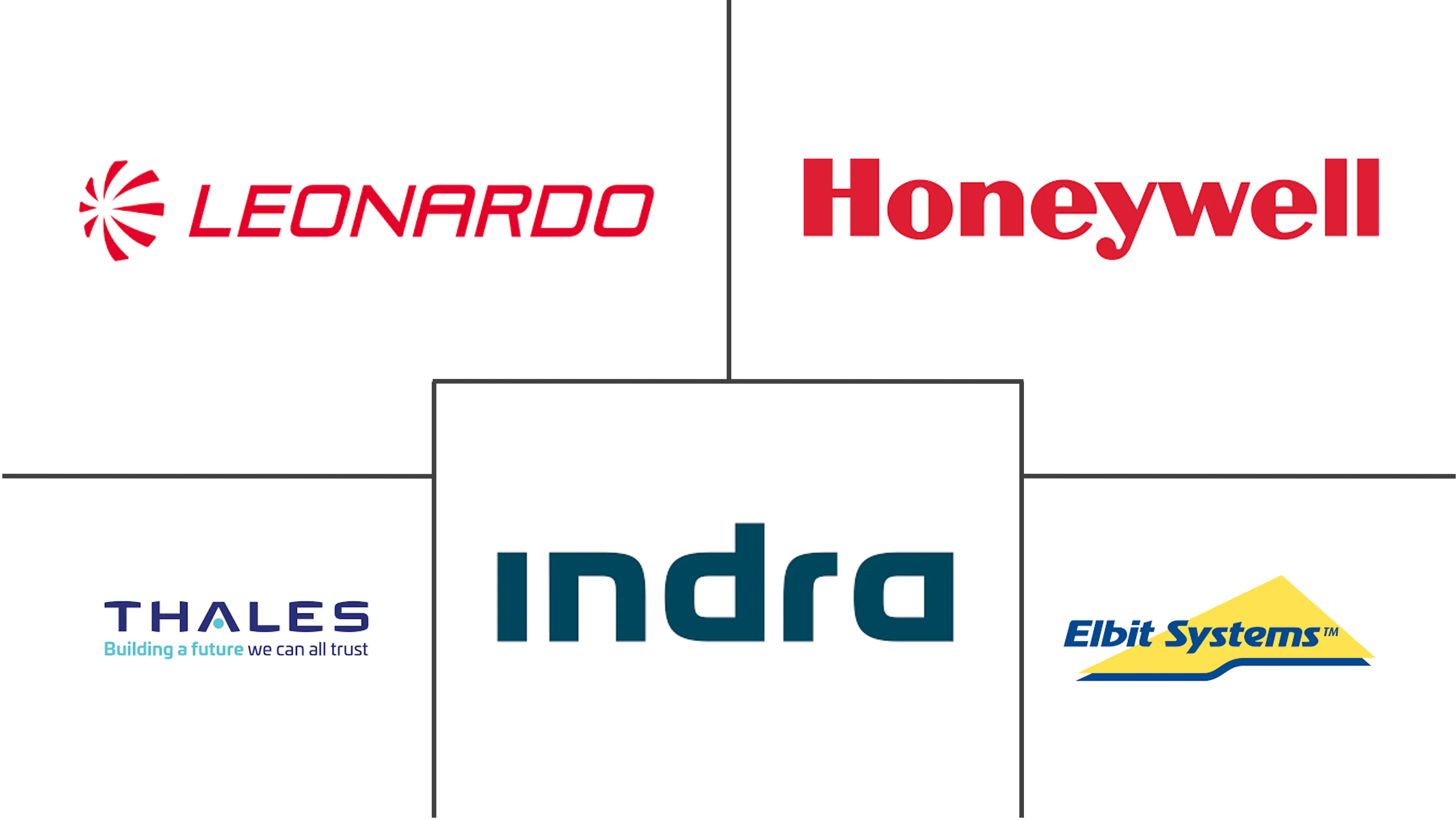Market Size of Middle-East And Africa Air Traffic Management Industry

| Study Period | 2019 - 2029 |
| Base Year For Estimation | 2023 |
| Market Size (2024) | USD 524.18 Million |
| Market Size (2029) | USD 581.45 Million |
| CAGR (2024 - 2029) | 1.74 % |
| Market Concentration | Medium |
Major Players
*Disclaimer: Major Players sorted in no particular order |
Middle-East and Africa Air Traffic Management Market Analysis
The Middle-East And Africa Air Traffic Management Market size is estimated at USD 524.18 million in 2024, and is expected to reach USD 581.45 million by 2029, growing at a CAGR of 1.74% during the forecast period (2024-2029).
The robust economic development in the Middle East and African region is fueling increased air travel demand, necessitating advanced air traffic management systems. Substantial investments in aviation infrastructure by governments to modernize airports and enhance airspace management contribute to the growth of the air traffic management market. The adoption of cutting-edge technologies such as AI, automation, and satellite-based navigation systems improves the efficiency and safety of air traffic management in the region.
The growth in passenger traffic is inviting investments in the market. The growing emphasis on modernizing air traffic management infrastructure is also driving the market’s growth. With a positive outlook for the global air passenger traffic numbers in the next 10 years, airlines are increasing their fleet size to cater their services to more passengers. Airlines are procuring more aircraft and adding more routes, thereby increasing the number of flights to handle for the airports. As airspaces become busier, the necessity for better airspace management increases.
The growth in passenger traffic has necessitated the construction and expansion of new airports, which has resulted in the demand for new air traffic management (ATM) infrastructure and capacity improvements in the existing ATM systems. However, one key restraint to the market is the diverse regulatory landscape across the Middle East and Africa, leading to inconsistencies in airspace traffic management and coordination. This regulatory complexity can hinder the seamless integration of air traffic management systems, limiting the potential for streamlined and efficient operations. Another significant challenge is the limited or outdated infrastructure in certain countries, especially in Africa, which can impede the implementation of advanced air traffic management technologies.
Middle-East and Africa Air Traffic Management Industry Segmentation
Air Traffic Management (ATM) encompasses all systems that assist aircraft in departing from an airport, transiting airspace, and landing at a destination airport, including airport radars and air traffic control towers. To provide a holistic overview, military air traffic management systems jointly managed with civil ATM agencies are also covered in the study's purview.
The Middle East and African air traffic management market is segmented by domain, component, and geography. By domain, the market is segmented into air traffic control, air traffic flow management, and aeronautical information management. By component, the market is segmented into hardware and software. The report also covers the market sizes and forecasts in six countries across the region. For each segment, the market sizing has been done in terms of value (USD).
| Domain | |
| Air Traffic Control | |
| Air Traffic Flow Management | |
| Aeronautical Information Management |
| Component | |
| Hardware | |
| Software |
| Geography | |
| Saudi Arabia | |
| United Arab Emirates | |
| Egypt | |
| Turkey | |
| Bahrain | |
| South Africa | |
| Rest of Middle East and Africa |
Middle-East And Africa Air Traffic Management Market Size Summary
The Middle-East and Africa air traffic management market is experiencing growth driven by robust economic development and increased air travel demand in the region. Governments are making substantial investments in aviation infrastructure to modernize airports and enhance airspace management, which is fueling the market's expansion. The adoption of advanced technologies such as artificial intelligence, automation, and satellite-based navigation systems is improving the efficiency and safety of air traffic management. The growing emphasis on modernizing infrastructure and the positive outlook for global air passenger traffic are encouraging airlines to expand their fleets and routes, thereby increasing the demand for efficient airspace management solutions.
Despite the growth prospects, the market faces challenges due to the diverse regulatory landscape across the Middle East and Africa, which can lead to inconsistencies in airspace traffic management. Limited or outdated infrastructure in certain countries, particularly in Africa, also poses challenges to the implementation of advanced technologies. The hardware segment is expected to dominate the market, driven by the demand for advanced components like radar systems and navigation devices. Strategic partnerships and collaborations with international players are helping countries like Saudi Arabia and the UAE to upgrade their air traffic control systems and accommodate growing air traffic demands. These efforts are expected to significantly contribute to the region's aviation advancement and the overall growth of the air traffic management market.
Middle-East And Africa Air Traffic Management Market Size - Table of Contents
-
1. MARKET DYNAMICS
-
1.1 Market Overview
-
1.2 Market Drivers
-
1.3 Market Restraints
-
1.4 Porter's Five Forces Analysis
-
1.4.1 Bargaining Power of Buyers/Consumers
-
1.4.2 Bargaining Power of Suppliers
-
1.4.3 Threat of New Entrants
-
1.4.4 Threat of Substitute Products
-
1.4.5 Intensity of Competitive Rivalry
-
-
-
2. MARKET SEGMENTATION
-
2.1 Domain
-
2.1.1 Air Traffic Control
-
2.1.2 Air Traffic Flow Management
-
2.1.3 Aeronautical Information Management
-
-
2.2 Component
-
2.2.1 Hardware
-
2.2.2 Software
-
-
2.3 Geography
-
2.3.1 Saudi Arabia
-
2.3.2 United Arab Emirates
-
2.3.3 Egypt
-
2.3.4 Turkey
-
2.3.5 Bahrain
-
2.3.6 South Africa
-
2.3.7 Rest of Middle East and Africa
-
-
Middle-East And Africa Air Traffic Management Market Size FAQs
How big is the Middle-East And Africa Air Traffic Management Market?
The Middle-East And Africa Air Traffic Management Market size is expected to reach USD 524.18 million in 2024 and grow at a CAGR of 1.74% to reach USD 581.45 million by 2029.
What is the current Middle-East And Africa Air Traffic Management Market size?
In 2024, the Middle-East And Africa Air Traffic Management Market size is expected to reach USD 524.18 million.

